Majolica offers a colorful window into the world of British and American life in the second half of the nineteenth century. Learn why the 15 objects in this audio guide look the way they do and how they might have been used in the Victorian home. Your audio docent, Nicholas de Godoy Lopes, is a Bard Graduate Center PhD student who selected the objects especially for this guide. Exploring their historical and cultural contexts, each brief description reflects on the tastes, habits, anxieties, and beliefs of those who designed, made, and used them.

Photograph © Bruce M. White
First Floor
Second Floor
Third Floor
Fourth Floor
Star of Bethlehem

John Bell (1811–1895), designer
Minton & Co., Stoke-upon-Trent, Staffordshire, manufacturer
Designed ca. 1863; this example 1864
Earthenware with majolica glazes
The English Collection
Photo: Bruce White
Nineteenth-century Britain saw the simultaneous rise of the urban middle class, office and factory work, and a more widely accessible consumer market. These developments aided a new conception of the home as a space that was separate from the workplace and filled with objects that contributed to a sense of rejuvenation or relaxation from the stresses of the day. Such objects could include this depiction of the infant Jesus, whose beatific appearance signaled that the interior it ornamented was a calming and spiritually elevating space. The choice of the artist to render Jesus as a life-like napping baby suggests the increased cultural sensitivity to childhood as a distinctive stage of life marked by innocence and vulnerability. It also could signal the virtuous motherly tendencies of the lady of the house at a time when contemporary religious figures and writers on the home promoted women as its moral guardian.
Filling the home with artistic objects like this also spoke to the taste and refinement of its occupants. Potential customers would likely have understood that this object was a ceramic version of a sculpture by the established artist John Bell. It therefore demonstrates that ceramics coexisted with a range of media, including plaster casts, prints, and bronze statuettes, that increasingly offered middle- and working-class consumers the chance to have affordable art in their home through mass-produced means. The rise of well-developed industries dedicated to providing copies and reductions of famous Greek statues, Raphael paintings, or works by the most noted contemporary artists made the apparent sanctity or rarity of high art increasingly irrelevant. Several artists, including Bell, in the name of increasing accessibility to art, encouraged the commercial production of their work and provided designs for manufacturers.

Garden seat
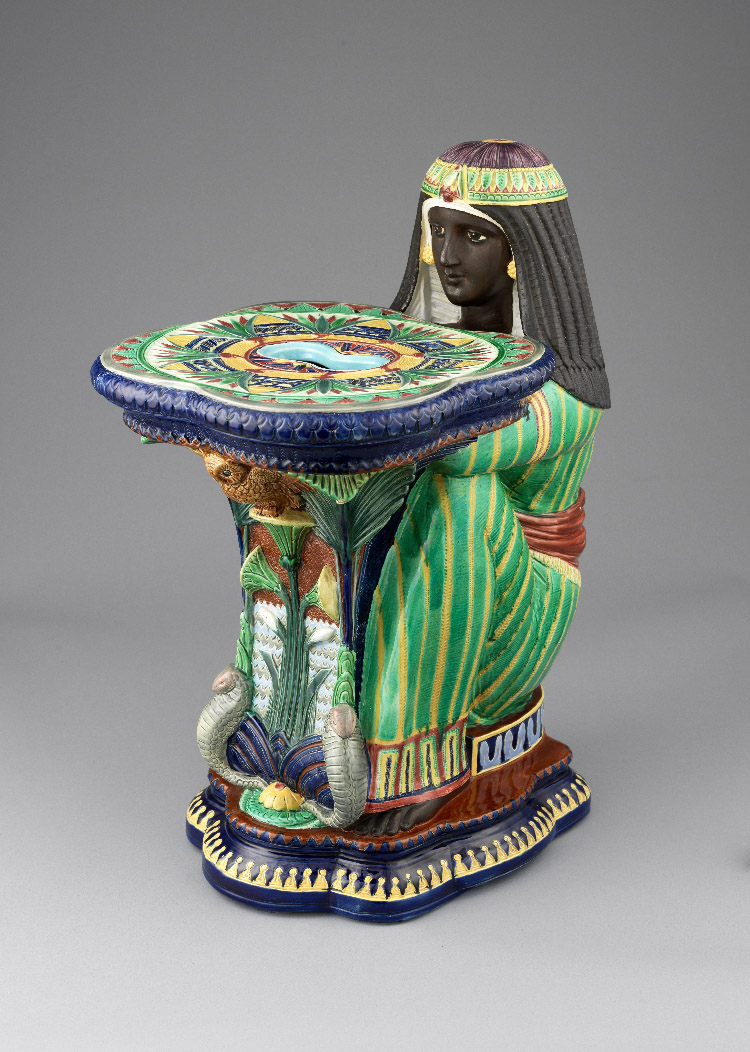
T. C. Brown-Westhead, Moore & Co., Hanley, Staffordshire
ca. 1880
Earthenware with majolica glazes
Joan Stacke Graham Collection
Photo: Bruce White
British manufacturers engaged in theatrical and often insensitive depictions of foreign cultures. As objects such as this Brown-Westhead, Moore & Co. garden seat show, signs of the “exotic” were often conveyed by clustering stereotypical motifs. These elements were usually drawn from contemporary pattern books. Owen Jones’s 1856 Grammar of Ornament, for example, depicted motifs from many cultures, including Egyptian, removed from their original contexts, which facilitated the free combination of them in new designs. Bright tones could also be connected with non-European cultures and their art and was often used in sculptural depictions of non-European peoples. Large, boldly colored decorative figures such as this reflect the changing understanding of color’s place in sculpture. The European artistic tradition had long upheld an aesthetic of bare stone based on the bleached surfaces of classical Greek, and Roman statues. However, extended disputes in the nineteenth century over whether these ancient models were originally vividly painted as well as reassessments of non-Western art increasingly challenged beliefs that colored sculpture was inherently crude, vulgar, and merely ornamental.
Using bright colors, the manufacturer has transformed the depicted Egyptian figure into an ornament. The green of the individual’s robes would have complemented the colors of the garden, connecting him or her visually to the exotic flora such as palms and orchids that would have surrounded this seat. Like many “blackamoors,” sculpted figures of black people displayed in wealthy European and American households, this Black body serves his or her purpose with no visible resistance and a mute, unreadable expression. By portraying a person as a compliant object, this seat demonstrates how decorative arts objects could visualize the power imbalance and racism at the heart of Western imperialism.

Prometheus Vase
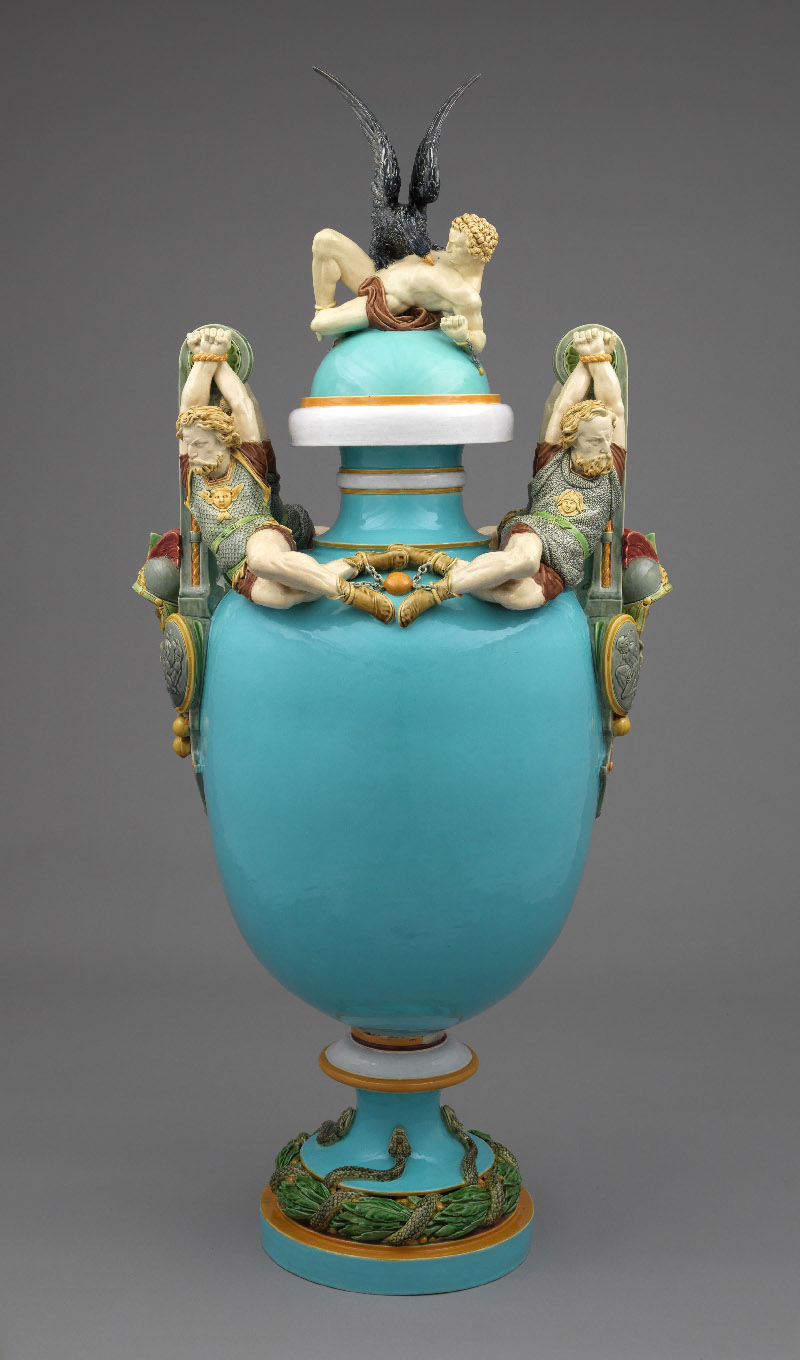
Victor Étienne Simyan (1826–1886), designer
Minton & Co., Stoke-upon-Trent, Staffordshire, manufacturer
Designed ca. 1867; this example 1873
Earthenware with majolica glazes
The English Collection
Photo: Bruce White
The Prometheus Vase by Victor-Étienne Simyan was one of Minton’s most celebrated majolica models. Numerous examples of this piece were made to showcase the company’s artistry at world’s fairs throughout the late 19th century, including the Paris Exposition Universelle in 1867 and the Vienna International Exhibition in 1873. Some versions feature ornate Renaissance-inspired painted decoration or mythological scenes in color schemes that range from blue-and-white to shades of red and brown. However, it was the pure turquoise-glazed version shown here that received the most praise. At the Paris Exposition Universelle in 1878, one commenter said it had “the finest color in the exhibition.” At the 1876 Centennial Exhibition in Philadelphia, another critic remarked on the beautiful contrast between the even plainness of the vase’s body and the intricacy of its figural elements. It was this turquoise blue version that also saw great commercial success in the United States among the Gilded Age elite.
The vase embodies many of the most appealing aspects of majolica. The intense and novel colors, the product of extensive experimentation by manufacturers, were praised as both artistic and technical achievements. Its classical figures showcase the skillful modeling that transformed the best examples of majolica into miniature sculptures for the home. Contemporary criticism also acknowledged the talent majolica designers had in imitating other materials from fur to stone. One critic discussing the captive soldiers on this vase’s handles claimed that these decorations “imitated so exactly the appearance of metal that one could hardly believe it to be, as it was, entirely of china.” This statement is somewhat humorous, as Simyan’s design was likely inspired by an elaborate silver vase displayed at the 1851 Great Exhibition in London.

Teapot
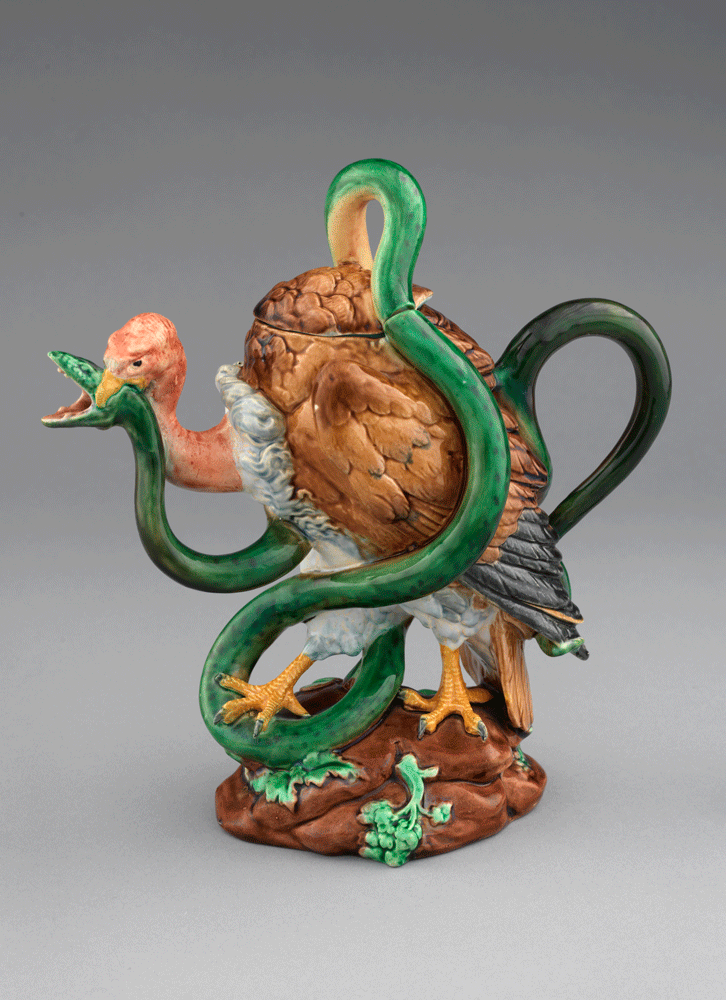
Henry Hope Crealock (1831–1891), designer
Minton & Co., Stoke-upon-Trent, Staffordshire, manufacturer
Thomas Goode & Co., London, retailer
Designed 1873; this example 1874
Earthenware with majolica glazes
Joan Stacke Graham Collection
Photo: Bruce White
Despite the differences in scale and imagery between the large showpieces displayed throughout this gallery and this teapot, they are connected by Minton & Co.’s ambition to lead an artistic revitalization of British manufacturing. Designers, makers, and critics in the late nineteenth century often discussed the need to develop a new era of creativity in production that emulated or surpassed historical precedents. Manufacturers, in particular, sought to fuse the worlds of fine and decorative art by hiring painters and sculptors as designers, bringing high standards of sculptural complexity, ambitious subject matter, and learned historical referencing into design studios. This teapot, for example, reimagines this well-established ceramic form as a scaffold for a dynamically unfolding drama. The transformation of the handles and spout into a writhing, hissing snake shows how natural imagery in household goods appealed to artists as a means of creating intimate yet thrilling aesthetic experiences.
Objects like these also reflect Victorians’ complex attempts to come to terms with a violent world. The rise of Darwinian evolutionary theory encouraged a view of nature defined by cruel and uncompromising conflict, a perception that was extended to the interaction of societies as well. European and American imperialist ambitions of the time led to near constant military activity. The teapot’s designer Colonel Henry Hope Crealock was notably present at three of Britain’s most aggressive campaigns: the Second Opium War against China in the 1850s, the aftermath of the 1857-8 Indian Revolt, and the 1879 Anglo-Zulu War. The imagery of this teapot may have upset many consumers aware of these ever-present conflicts. However, by molding dark subject matter into a traditionally genteel object, the vessel could have rendered this awareness more bearable, turning something threatening into something harmlessly absurd.

Dish with portrait of Queen Victoria
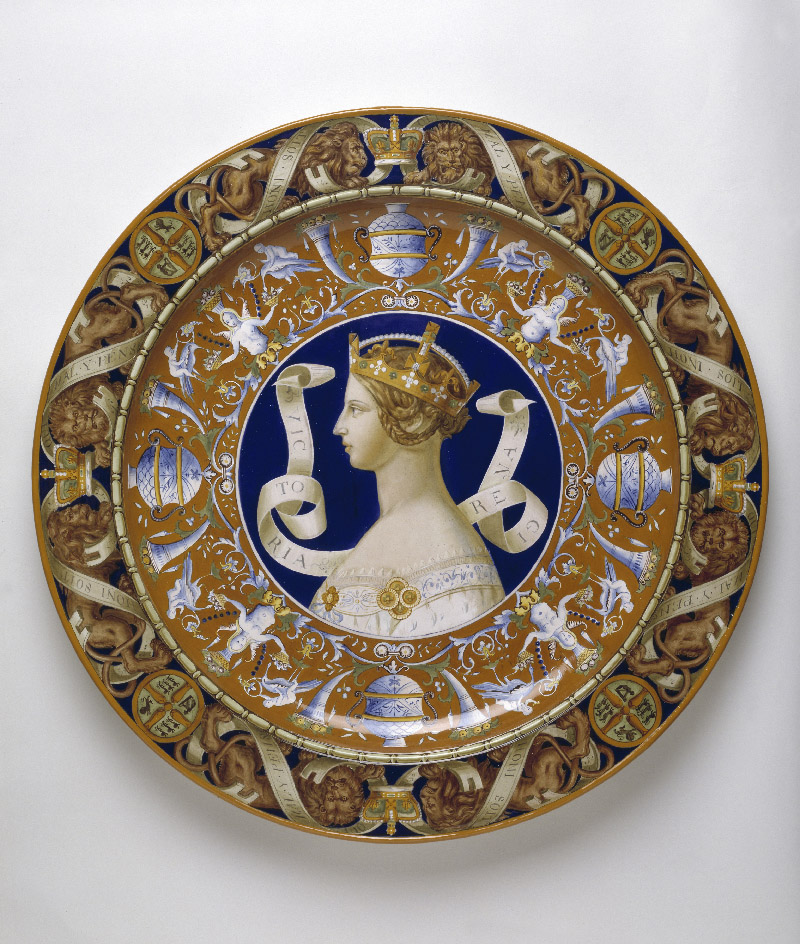
Thomas Kirkby (1824–1890), painter, after Silas Rice (1821–1873), designer
Minton & Co., Stoke-upon-Trent, Staffordshire, manufacturer
ca. 1855
Earthenware with majolica glazes painted in enamels
© Victoria and Albert Museum, London, 3340-1856
This dish’s imagery directly evokes maiolica, a brightly painted tin-glazed earthenware popular in the Renaissance that was first exhibited in England in the mid-nineteenth century and became the main inspiration for Victorian majolica. However, these earlier wares were not immediately popular with art critics. One reviewer, for instance, said the ceramics, “though elaborately finished and exhibiting exuberance of fancy,…sin too grossly against the canons of art to afford any great amount of pleasure to a mind of cultivated taste.” Many of the critiques against Renaissance ceramics, including their bright colors and fantastic imagery, would be used against majolica itself. However, the creativity cited by the critic would also paradoxically be used to praise both the old and new wares. Such artistry is present in this Minton dish in the beautifully rendered profile of Queen Victoria and the border of Renaissance-style grotesques.
The acceptance of Renaissance maiolica and Victorian majolica as objects worthy of collection and display developed primarily through the patronage of the royal family and the establishment of the South Kensington Museum, now the Victoria & Albert Museum, which purchased this dish in 1856. Queen Victoria and Prince Albert had a substantial collection of Renaissance maiolica and patronized the South Kensington Museum since its beginnings as the Museum of Ornamental Manufactures in 1852. The museum soon acquired the large collection of maiolica owned by the French collector Jules Soulages and was gifted examples from the royal collection. These acquisitions established maiolica as royally and academically endorsed examples of artistic household goods suitable for imitation. The museum maintained a role throughout the century of providing contemporary manufacturers with examples of foreign and historical objects that would inspire high-quality, imaginative design.

Teapot
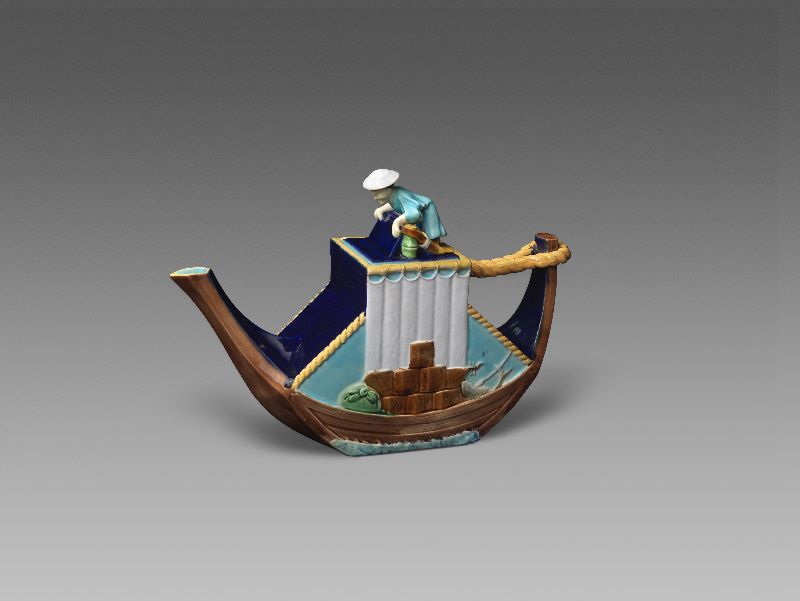
George Jones & Sons, Stoke-upon-Trent, Staffordshire
Design registered 1876
Earthenware with majolica glazes
Collection of Marilyn and Edward Flower
Photo: Bruce White
Much imagery on majolica visually celebrated the increasingly interconnected nineteenth-century globe. Wares ranging from garden stands wrapped in banana leaves to jugs in the form of corncobs underlined middle-class consumers’ access to goods, foods, and even animals from around the world. Tea was perhaps the most important commodity of them all. In the nineteenth century, tea became the beverage of choice for British consumers of all classes. The total integration of tea within the country’s cultural life was aided by the United Kingdom’s development of tea farms in the Assam region of India when the country was still a colony of the British empire, which at this time occupied parts of Africa, Asia, Oceania, and the Americas. The cultivation of tea in India allowed the British market to gradually reduce its reliance on China for the plant product. Tea thereafter became not only a symbol of Asian culture but part of Britain’s own image of its imperial might. By the 1880s, India supplanted China as the main source of the tea imported into the United Kingdom.
This George Jones teapot in the shape of a Chinese shipping junk, or ship, comments through its clever imagery on the international nature of this agricultural product. It is a “vessel” for tea that depicts a vessel for tea. The middle-class consumer who owned this teapot might have reflected on the path its contents took to reach their table and their nation’s power in distant lands. Notably, references to China remained common in majolica teapots even as the Indian tea exports grew, showing that the association of tea with China remained. The object therefore speaks to the economic interactions of several nations. Whether the teapot held Indian black or Chinese green tea, the Chinese figure on its top is frozen in the act of transporting the good to its British consumer and thereby eternally in service to British trade.

Spill vase
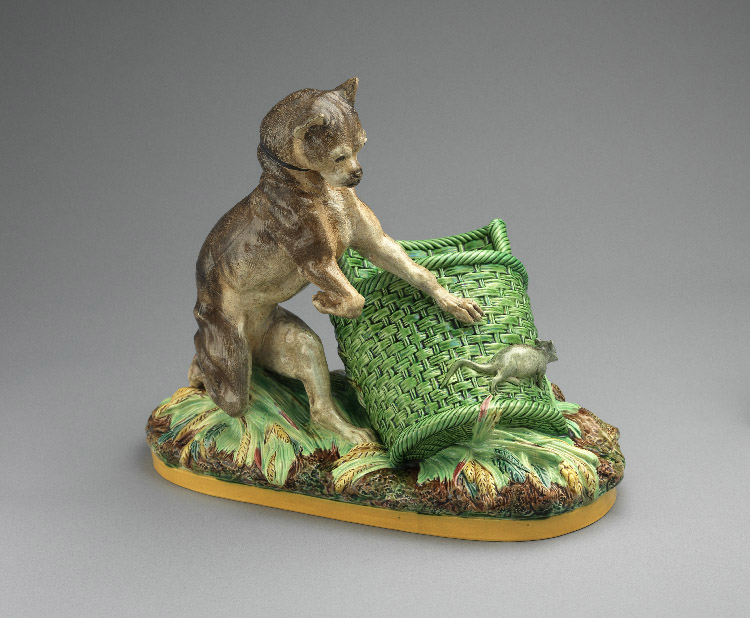
Henri-Émile-Adrien Trodoux (active 1837–78), designer
T. C. Brown-Westhead, Moore & Co., Hanley, Staffordshire, manufacturer
ca. 1878
Earthenware with majolica glazes
The English Collection
Photo: Bruce White
Immigrant French artists were essential contributors to the creative designs realized by English majolica manufacturers. Often coming to the UK to escape the political unrest that plagued France throughout the century, they brought several artistic traditions unique to their homeland, including the animalier, or animal-subject, genre. This spill vase by the French sculptor Henri Emile Adrien Trodoux is an excellent example of the animalier tradition being adapted to household goods. Typical of such sculpture is the careful attention to detail as seen in the dog’s fur and its dramatic pose, which invests the animal with an almost-human sense of curiosity and surprise. In a period that saw the first widespread pet ownership and new theories of animal intelligence, sympathetic depictions of animals such as this were increasingly common. Dogs in particular were popular subjects of portraits–representations that capitalized on their associations with faithfulness and their ability to convey human-like emotion.
Trodoux copied the dog’s pose from one of his bronze sculptures but added other details to make the object functional, most notably the green basket. This transforms the object from a humorous depiction of animal behavior to an evocative suggestion of rural life that might appeal to an urban audience. Romantic depictions of country lifestyles appeared in popular culture as people increasingly moved to bustling yet grimy and crowded cities such as London, Manchester, and New York. Evocations of rural life were realized not only through the choice of motifs but also through the skillful treatment of textures such as the interwoven fibers of the basket seen in this vase. Similarly masterful modelling is seen on many of the Brown-Westhead, Moore & Co. objects displayed here, showing the fruitful relationship between artists and manufacturers at this time.

Teapot
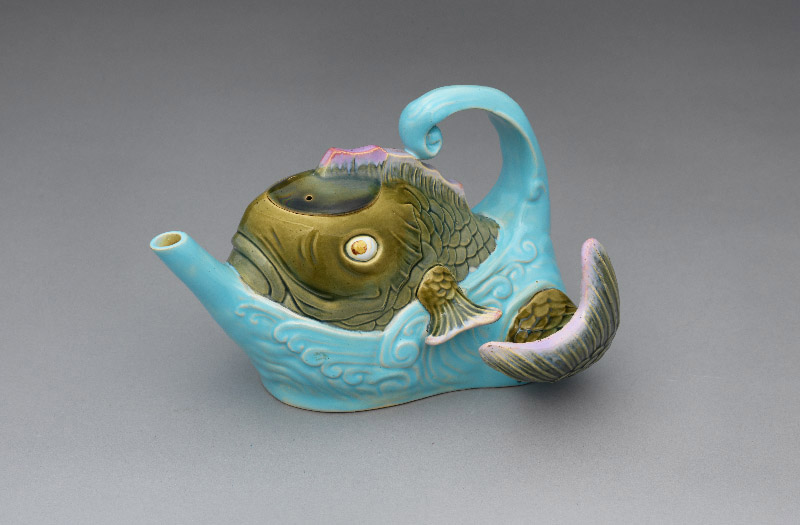
William Brownfield & Sons, Burslem, Staffordshire
Design registered 1876; this example 1878
Earthenware with majolica glazes
Private collection
Photo: Bruce White
Playing up the visible disjunction between the stylized wave and the bizarre fish that pierces through it, this Brownfield teapot turns the typical balance between function and aesthetics on its head. The uneven and glistening olive glaze makes the fish’s slick scales feel palpable, while its tail grabs our attention by jutting sharply into our space. One can easily imagine this displayed as a curio, and in this regard, it is an eye-catching example of how Victorians used fanciful objects as vessels for humor, wonder, and exhilarating disruption of the everyday. Its small yet tactile body also speaks to a quintessentially Victorian desire to possess unusual objects and to enjoy the pleasures of touching and holding they offered.
This teapot’s fish suggests the influence of Japan through its strongly expressive yet still naturalistic face and form. After the mid-nineteenth century, when the country was forcibly opened to broad Western trade by the United States, artists and designers increasingly looked to Japanese art, particularly prints and carvings, for inspiration in creating fanciful and caricature-like images of animals. The designer Christopher Dresser claimed, for example, that Japanese artists “can make an insect appear pleased, a crab look as though it smiled, a herring wag its tail with delight, or an octopus perform on a musical instrument, and yet seem natural; in short, they appear to know the ways of birds, insects, fishes, and other things; and to be able to make themselves feel as these creatures do.” Comments like Dresser’s show a typically Victorian mix of infantilization and genuine admiration for another culture. However, contact with Japanese art undoubtedly inspired Victorian designers to try fresh approaches to depicting animals, as apparent in comparing this teapot with the more traditional imagery of the jug nearby.

Shell and Lizard

Worcester Royal Porcelain Company, Worcester, Worcestershire
Designed ca. 1868
Earthenware with majolica glazes
Collection of Marilyn and Edward Flower
Photo: Bruce White
In the Renaissance, when the nautilus cups that inspired this vase were made, craftspeople often sought to rival the artistic genius they believed nature possessed. The transformation of nautilus shells through gold mounts into vessels showed how art could add to the beauty of nature itself to produce objects worthy of princely collections. This Royal Worcester majolica vase suggests that Victorians saw themselves as inheritors of this interest in blurring the boundary between real and artificial. The carefully controlled glaze and pale clay body effectively evoke the fragile porcelain-like shell of the animal. The dynamic lizard, who appears to snap at the hand of whoever reaches for the vase’s contents, asserts the ability of art to imitate life. The buyer of such a vessel could share in Renaissance princes’ delight over the visible mastery of nature by human hands.
Nineteenth-century comments on the nautilus show that the historic view of it as a natural art object persisted and gained new elements. “Such is the nautilus,” said one Victorian scientist, “a thing so graceful, that when we look at it we are content to say with [the poet John] Keats — ” ‘ A thing of beauty is a joy for ever ;’.” He further states that it is such a perfect example of engineering that it would be of use to shipbuilders to study. By describing the nautilus with reference to ships, his words suggest that evocations of the ocean and the global trade it facilitates were an essential part of its shell’s appeal. The nautilus was itself a commodity in this trade. For centuries, its shells came to Europe from the Indian Ocean. Its exotic associations likely gained new meaning for the British in the Victorian period as the United Kingdom colonized the Indian subcontinent.

Umbrella stand
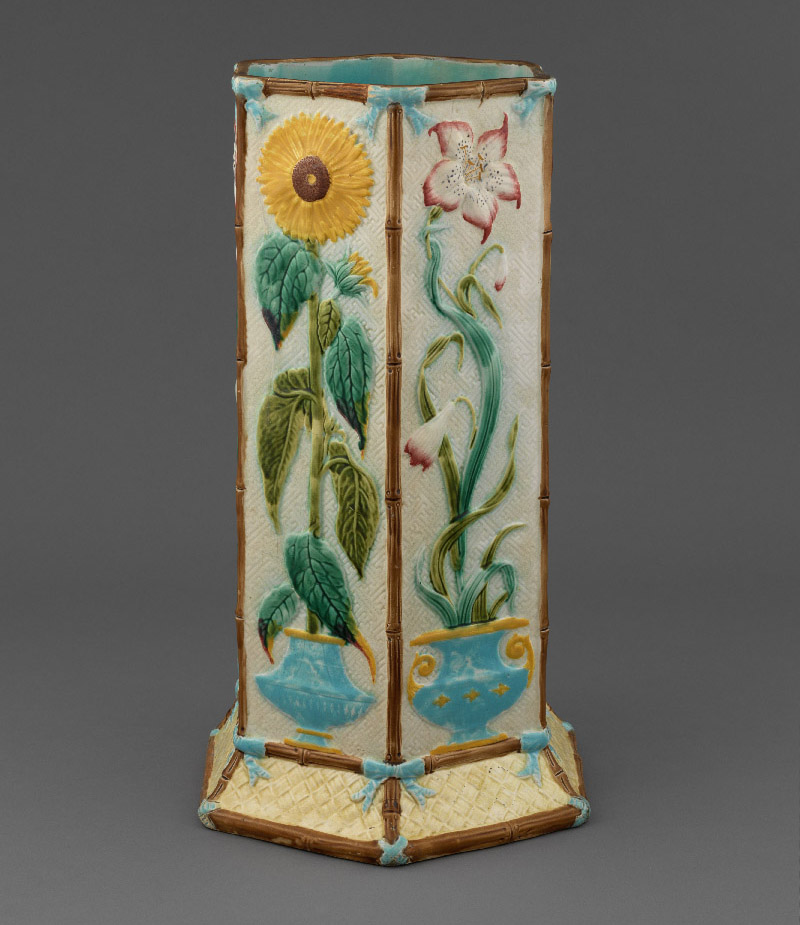
S. Fielding & Co., Stoke-upon-Trent, Staffordshire
ca. 1881
Earthenware with majolica glazes
Private collection
Photo: Bruce White
The umbrella stand was an important furnishing in the Victorian middle-class household. Designed to hold not only umbrellas, but also walking sticks and ladies’ parasols, it was often found in the hall, the entry point in the home where visitors waited until they were allowed further in or turned away. The activity of visiting was an omnipresent feature in Victorian life, especially among middle-class women, who were expected to call on each other frequently for tea and conversation. The resilient ceramic material of majolica made it ideal for enduring the occasional bang from an umbrella, and its waterproof quality also made it perfect for catching rain droplets.
As the umbrella stand was one of the first objects seen upon entering the house, it was an important statement to visitors of the owner’s artistic tastes. This stand reflects the ideals of the late nineteenth-century Aesthetic movement, whose followers sought to transform the home into a refined, artistic, and spiritually elevating space. The pale colors reflected a push against visual garishness, and the rendering of the flowers shows the movement’s preference for flat patterning and controlled, restful compositions. The sunflower and lily were frequently paired in Aesthetic movement decorations because of their visual contrast and their symbolic associations, which reflected a particular understanding of the ideal art experience. The sunflower’s turn toward the sun signified longing, and the lily signified purity. Quickly, however, the pairing became a decorating trope and a means of parodying the movement’s advocates in the press. Images of men and women admiring and even pining over the flowers poked fun at these bohemian individuals, who, as one American writer claimed in 1882, were believed to “dine upon the beauty of a lily” and “ebb out incessantly into ecstasy over sunflowers and crockery.”

Seal Ice Pail

Josiah Wedgwood & Sons, Stoke-upon-Trent, Staffordshire
Designed ca. 1878–79; these examples 1879
Earthenware with majolica glazes
Rena and Sheldon Rice
Photo: Bruce White
It’s hard to imagine a world in which ice cream is not widely available, but until the mid-nineteenth century, the treat was common only among the elite. This changed with the rise of a commercial ice industry in the 1840s and 50s, when developments in transportation allowed ice harvested or manufactured in colder climates to be shipped globally. In the 1840s, the first ice cream makers were patented in the United States and Britain, and their invention, along with the availability of commercial iceboxes, opened the way for home production of the frozen desert. As a result, the popularity of ice cream increased rapidly. Cookbooks devoted to ices and ice creams published in the last decades of the century testify to an interest in finding creative ways to serve it at formal occasions. One 1894 book, for instance, suggests offering asparagus-flavored ice cream molded to look like the vegetable or vanilla and chocolate ice cream molded in the shape of a duck.
Ice cream was often served shaped as a loaf on servers such as this example made by Wedgwood. Its decoration makes a humorous allusion to the dessert’s iciness but also demonstrates the Victorian fascination with the frozen North. This interest increased as a result of events such as the vanished arctic expedition of Sir John Franklin in 1845 and the 1867 purchase by the United States of the lands that would become the state of Alaska. The Arctic’s place in popular culture was strengthened by the work of individuals such as the American painter Frederic Edwin Church and the Scottish novelist Dr. William Gordon Stables. Most of their depictions emphasized the harshness and grandeur of the polar environment, but this tray evokes the region with light-heartedness. Its cavorting swimming seals would be slowly revealed as the ice cream was eaten, while the placement of two of these warm-blooded, blubbery mammals as the tray’s handles suggests a tactile pleasure as well.

Water cooler and cover
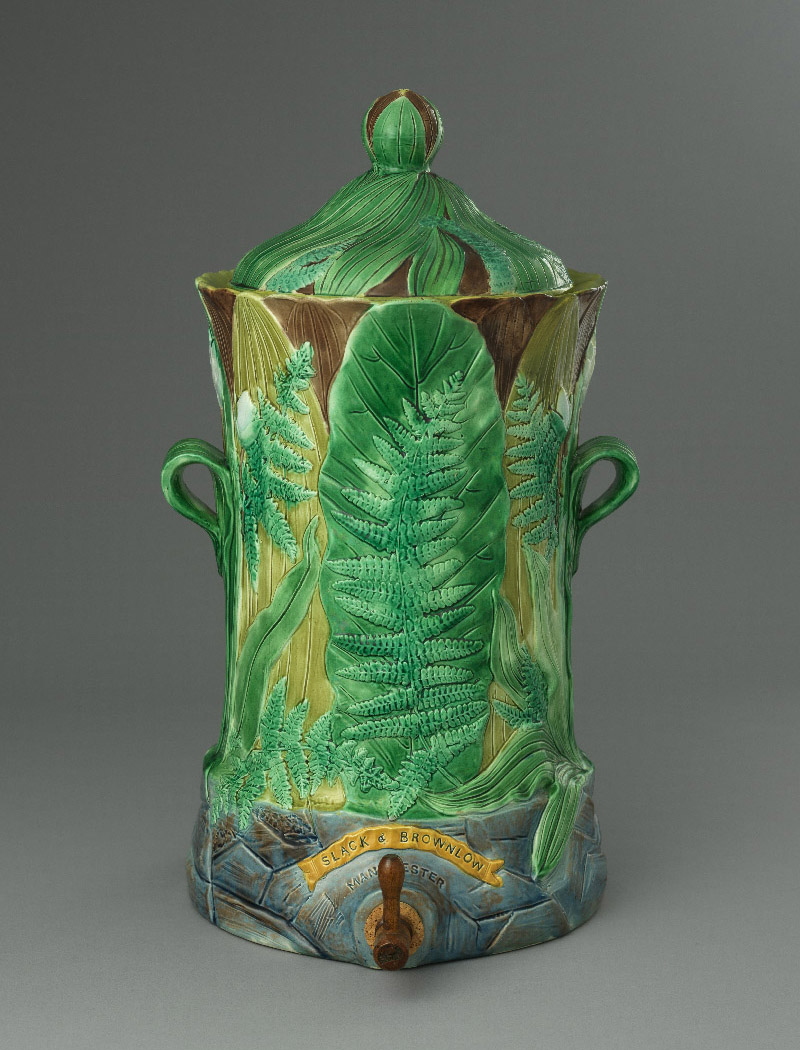
Joseph Holdcroft, Longton, Staffordshire, for Slack & Brownlow, Manchester, Lancashire
ca. 1870s–80s
Earthenware with majolica glazes, metal, cork, and wood
Aviva and Gerald Leberfeld
Photo: Bruce White
In the rapidly industrializing nineteenth-century city, matters of hygiene and pollution loomed large. For many, the grime and the crowding of urban centers led to a desire to escape—at least visually–to the natural world, which was seen as essential to fostering health and well-being. This water cooler strongly evokes these positive ideas towards nature. Its vegetal decoration ties the clean water it supplies, achieved through the filter included within, to the wild forests and ponds beyond the dirt of the city. The presence of ferns, which flourish in moist terrain, emphasizes this connection, but also points to a Victorian fascination with the plants. Especially in Britain, a significant “fern craze” emerged in the second-half of the century in which middle- and upper-class individuals alike would gather ferns from the country-side and cultivate them in special glass cases in the home. By providing a little patch of green to interiors, these ferns both evoked the natural world and the memory of idyllic excursions outside the city.
The positive appeal of ferns in domestic interiors is beautifully expressed in Francis George Heath’s 1882 guide to their cultivation The Fern World. “Here, then,” he writes, “is a source of pleasure and delight! A little bit of the Fern world, dewy with moisture…green like the moss-covered side of the boulder of a moorland stream, and fresh with the scent of the moorland air, sealed up and brought to our homes…perched, if you will, on windows with the dreariest out-look, hanging there as a refreshing reminder of the moorland and woodland.” A similar romantic vision is apparent in this water cooler, which places its plants as if they were growing out of an old, crudely built stone wall. This motif seems to further distance the cooler and its contents from the harsh realities of modern, industrial life.

“American Porcelain. James Carr, New York.”
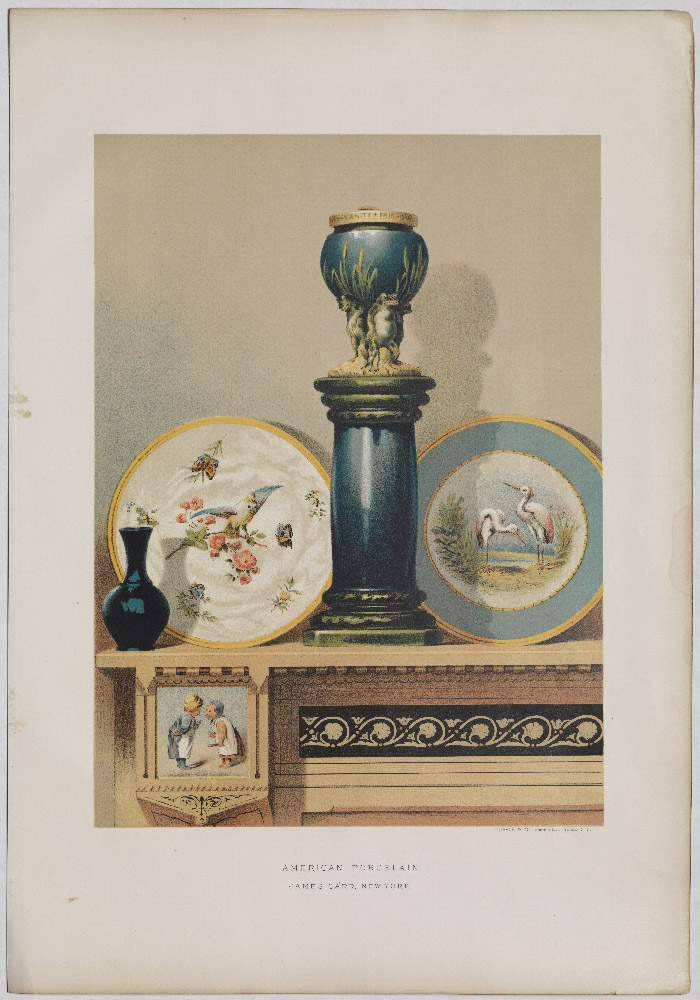
Plate 50 from Treasures of Art, Industry and Manufacture Represented in the American Centennial Exhibition at Philadelphia 1876, edited by Charles B. Norton
Buffalo: Cosack & Co., 1877
Chromolithograph
Private collection
Photo: Bruce White

Plate
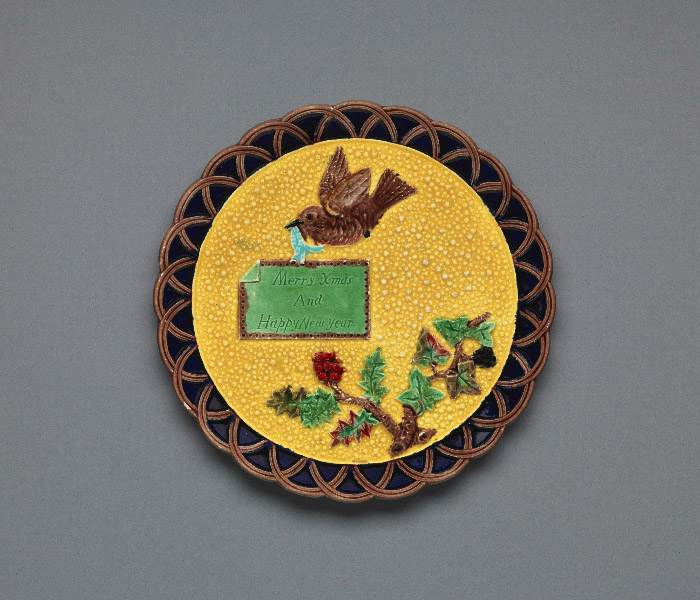
Eureka Pottery Co., Trenton, New Jersey
1883
Earthenware with majolica glazes
Private collection, ex coll. Dr. Howard Silby
Photo: Bruce White
By the late nineteenth century, Christmas was a thoroughly commercialized holiday. In an 1881 Harper’s Bazaar article on “The Art of Christmas Shopping,” an anonymous author discusses the complex balance of economic and sentimental factors familiar to any holiday shopper today. Ceramics rate highly among the suggestions for cheap yet heartfelt gifts, with both “majolica pitchers” and Japanese wares cited as suitable examples. The author describes the desire to keep a beautiful ceramic present for oneself but concludes that, “There is the real sacrifice to friendship…. now [that] you have selected it, and relinquished it too, for the sake of a Christmas offering, all the wealth of Aladdin’s lamp could not redeem it. Its money value is sunk in its sentimental value. Indeed, may not this truly be said of all Christmas gifts?” The holiday imagery of this plate, along with its fashionably Japanese-style asymmetric design of bird and branch, may have prompted a lot of thought on how even an inexpensive object can inspire a wealth of delight.
Unglazed sherds of this plate model were found in the archaeological excavation of the short-lived South Carolina Pottery Company. Their presence suggests that when Trenton’s Eureka Pottery closed, several of its molds, including the “Merry Xmas” plate, were bought by a local potter George W. Lawton and used to set up the new company in Miles Mill, South Carolina. The purchase of molds from defunct potteries was a common occurrence in an industry characterized by a high degree of uncertainty, as prospective company founders eagerly sought out resources with which to jumpstart their own production. Discoveries such as these remind us that any majolica design could, and often did, have an extensive afterlife.

Fruit Dish
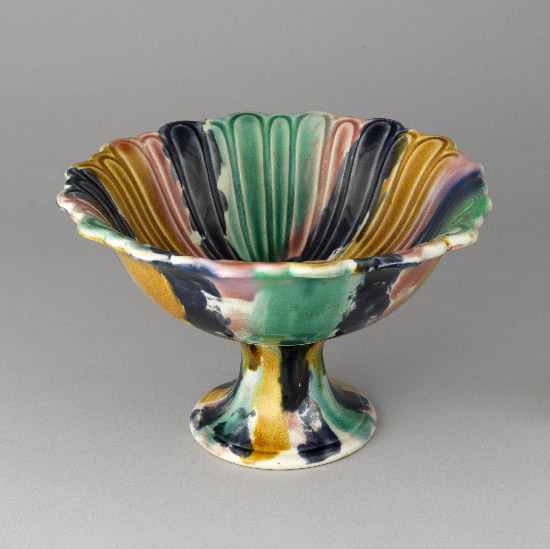
Morley & Co., Pioneer Pottery, Wellsville, Ohio
ca. 1881–84
Earthenware with majolica glazes
William and Donna Gray
Photo: Bruce White
The loose application of color to this fruit dish and other Pioneer Pottery wares nearby connects them to a wide range of similarly decorated ceramics produced since the early nineteenth century and often described with the term “fancy.” In the nineteenth century, “fancy” was often used as a synonym for the imagination and could also define the particular ability of the mind to react to pleasant visual stimulus quickly and to make mental images and associations rapidly. Applied to objects, as in the common period term “fancy goods,” it described ceramics, glass, and other small products made solely to be ornaments for the home and fodder for the mind’s need for novelty, excitement, and variety. Through the seemingly slapdash glazing that ensured no two examples would look alike, vessels such as this fruit dish could possess a sense of expressiveness and individuality despite being made in large quantities, thus providing much desired visual stimulation.
American majolica makers understood that these colorful ceramics were appealing additions to the range of white, monochrome, or plain wares that would otherwise grace working- and middle-class tables. Often companies simply expanded their lines by applying majolica lead glazes to the same models used for more utilitarian vessels. The same clays were often also used, including the thicker clays used for white granite or ironstone ware, as in this fruit dish, and the buff-colored clays used in yellow- and Rockingham ware. Transformed into novelty fancy goods, these visually upgraded ceramics were offered through a variety of retail venues, including general stores, specialty crockery emporiums, and even in grocery stores as giveaways with the purchase of kitchen staples like baking powder.
